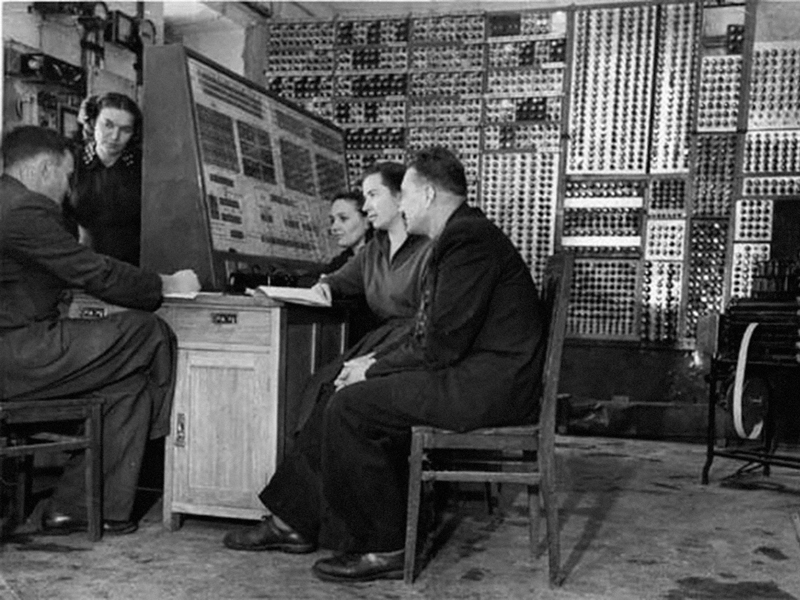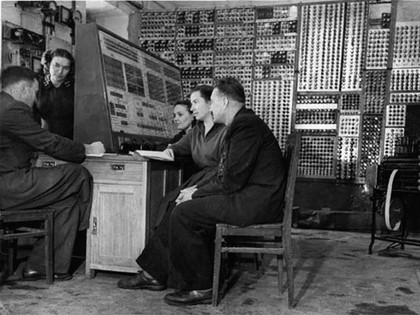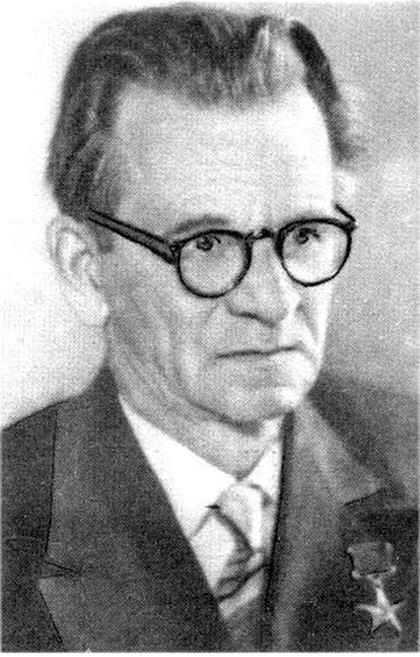
Cold War paranoia may have brought the world to the brink of destruction, but it sparked an era of invention on both sides of the pond.
In September 1950, fearing that Soviet computing trailed America by 15 years, Director of the Moscow Institute of Precise Mechanics and Computer Technology Mikhail Lavrent'ev outlined the problem in a speech to colleagues.
The Russians understood what worked, but they had only produced a handful of primitive analogue devices. New digital number-crunching systems gave their scientists the opportunity to make huge leaps forward, but at what cost?
This is the story of the machines they created, and how the technologies intended to boost Communism played a key part in toppling the Soviet state.
The secret laboratory
Building digital computers in Soviet post-war Russia was a dangerous business. To protect himself and his staff from criticism that could end in them being sent to labour camps, Russian computer pioneer Sergei Lebedev of the Kiev Electro-Technical Institute declared that the computers they wanted to build would carry out only ideologically correct calculations.
Described as 'the Soviet Alan Turing', Lebedev had been thinking about how to build a computer since 1948, and by the end of 1949 he had the basic principles down on paper. In a climate of deep suspicion, Lebedev assembled a team of 12 designers and 15 technicians at a disused monastery at Feofania, near Kiev, and gave it the seemingly ironic name 'Secret Laboratory Number One'.
Sign up for breaking news, reviews, opinion, top tech deals, and more.
The team's first machine was called MESM, which was short for 'Small Electronic Counting Machine' in Russian. It contained over 6,000 vacuum tubes and had its own small power station to overcome local supply difficulties.

NAMING FAIL: Called the Small Electronic Counting Machine, this computer was far from small
Running at just 3kHz, however, its performance was pretty woeful. Rostislav Chernjak is one of the few remaining members of the team that started work on the project. He spoke about the many difficulties involved in getting MESM running in a Radio 4 interview recorded in 2005.
"On the second floor was the laboratory and a larger room where we assembled the computer," Chernjak explained. "It needed seven kilowatts of power so it was very hot and we needed some cooling. We demolished a wall to make the room bigger but that wasn't enough – so we took the roof off."
That step must have solved the problem, because MESM ran its first test program on 6 November 1950. To make sure that it was working properly, two mathematicians were told to solve the same problem as the machine. MESM's results differed from those produced by the mathematicians.
The story goes that Lebedev stayed up all night trying to find out what was wrong with MESM – but by the following morning, he'd realised that the machine was right and that both mathematicians had made exactly the same mistake. MESM finally went into service on Christmas Eve 1951, making it the first stored-program digital computer within the Eastern Bloc.
The machine quickly began receiving a stream of secretive visitors who were keen to perform mysterious calculations. Thanks to the end of the Cold War, we can now piece together just what those calculations were.
The weapons race According to sociologist Slava Gerovitch, writing in the April 2001 edition of the journal Social Studies Of Science, atomic weapons were the most potent symbol of power in the post-war years, and Stalin demanded the biggest and best to wave in the faces of the West.
Atomic weapons physics devours computing time even today. Back in the '50s, physicists realised that they could create truly gigantic explosions using an atomic bomb to fuse together hydrogen atoms into a thermonuclear reaction. Also needed was a missile that was capable of firing such weapons into space and accurately dropping them on US targets.
The physics of intercontinental ballistics was in its infancy, but it was already ravenously number-hungry.
At the time, the only Russian source of computing power was Secret Laboratory Number One. Lebedev's team worked feverishly to create better machines that could accurately solve the calculations required to build such weapons.

SERGEI LEBEDEV: One of the godfathers of Communist computing, Sergei Lebedev led the team who created the MESM
Their next result was the BESM series. Completed in 1953, BESM-1 was the fastest computer anywhere in continental Europe. It handled 39-bit floating point numbers and had four magnetic tape units capable of storing 30,000 words each. Disk storage consisted of rotating magnetic drums storing 5,120 words each.
Also in 1953 came the massive, elegant but very underpowered Strela mainframe. Designed and built by the Moscow Plant of Computing-Analytical Machines, it occupied 300m2 of floor space and boasted 43-bit binary floating point notation. However, the system was extremely power-hungry. The CPU alone drew 75kW of power, with the cooling system and peripherals doubling that amount.
Despite executing a mere 2,000 instructions per second, the first Strelas went into service at Moscow's Design Bureau Number 1 of the Third Chief Directorate. They worked on problems relating to target destruction probability and detonation efficiency of fragmentation warheads. Eventually, all seven Strelas were shipped to the Russian Academy of Sciences' Division of Applied Mathematics, where they worked in parallel on nuclear and ballistic missile calculations.
But the scarcity of computer time was leading civilian scientists into conflict with their military counterparts. In 1955, the Computation Centre of the Academy of Sciences in Moscow became the first non-military computer bureau in Russia. Civilian researchers were allowed to run non-classified programs on its machines. At least, that was the original idea.
It turned out that nuclear weapons researchers (led by Igor Kurchatov) and missile and spacecraft designers (led by Sergei Korolev) monopolised resources. In James Hartford's book Korolev: How One Man Masterminded the Soviet Drive to Beat America to the Moon, Cosmonaut Gregori Grechko recalled fighting for computer time:
"Kurchatov's people used it in the daytime, and during the night Korolev's people [used it]. And for all the rest of Soviet science: maybe five minutes for the Institute of Theoretical Astronomy, maybe half an hour for the chemical industry."
The Soviet government was clearly prioritising the development of weaponry over research into areas that wouldn't be of use if war did break out.